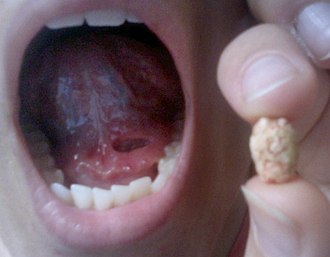Sialolithiasis
(Redirected from Salivary duct calculus)
Editor-In-Chief: Prab R Tumpati, MD
Obesity, Sleep & Internal medicine
Founder, WikiMD Wellnesspedia &
W8MD medical weight loss NYC and sleep center NYC
| Sialolithiasis | |
|---|---|
| Synonyms | Salivary stones, salivary duct stones |
| Pronounce | N/A |
| Specialty | N/A |
| Symptoms | Pain and swelling in the affected gland, especially during eating |
| Complications | Infection, abscess formation |
| Onset | Typically adulthood |
| Duration | Variable |
| Types | N/A |
| Causes | Dehydration, reduced salivary flow, trauma |
| Risks | Smoking, medications that reduce saliva production |
| Diagnosis | Clinical examination, imaging such as X-ray, ultrasound, or sialography |
| Differential diagnosis | Sialadenitis, tumors of the salivary glands |
| Prevention | N/A |
| Treatment | Hydration, massage, sialogogues, surgery |
| Medication | Analgesics, antibiotics if infected |
| Prognosis | N/A |
| Frequency | Common |
| Deaths | Rare |
Sialolithiasis is a medical condition characterized by the formation of calcified stones, known as sialoliths, within the salivary glands. These stones can obstruct the flow of saliva, leading to pain, swelling, and infection of the affected gland. Sialolithiasis most commonly affects the submandibular glands but can also occur in the parotid and sublingual glands.
Causes
The exact cause of sialolithiasis is not fully understood, but several factors are believed to contribute to stone formation, including dehydration, reduced saliva flow, increased calcium concentrations in saliva, and the presence of bacterial infections.
Symptoms
Symptoms of sialolithiasis may include:
- Pain and swelling in the affected salivary gland, especially during meals
- Dry mouth
- Difficulty swallowing
- A noticeable lump in the area of the affected gland
- Recurrent infections of the salivary gland
Diagnosis
Diagnosis of sialolithiasis involves a combination of clinical examination, imaging studies such as X-rays, ultrasound, or Sialography, and sometimes MRI or CT scans to locate the sialoliths and assess the extent of gland involvement.
Treatment
Treatment options for sialolithiasis include:
- Conservative measures such as hydration, warm compresses, and massage to facilitate stone expulsion
- Sialogogues (saliva-inducing agents) to increase saliva flow
- Antibiotics for secondary infections
- Minimally invasive procedures such as shock wave lithotripsy to break up stones
- Surgical removal of the stone through sialendoscopy or open surgery in more severe cases
Complications
If left untreated, sialolithiasis can lead to chronic infection, abscess formation, and permanent damage to the salivary gland.
Prevention
Preventive measures may include adequate hydration, good oral hygiene, and regular dental check-ups to maintain optimal salivary flow and reduce the risk of stone formation.
See Also
External Links
- National Institute of Dental and Craniofacial Research - Salivary Gland Disorders
- Mayo Clinic - Sialolithiasis
Transform your life with W8MD's budget GLP-1 injections from $125.
W8MD offers a medical weight loss program to lose weight in Philadelphia. Our physician-supervised medical weight loss provides:
- Most insurances accepted or discounted self-pay rates. We will obtain insurance prior authorizations if needed.
- Generic GLP1 weight loss injections from $125 for the starting dose.
- Also offer prescription weight loss medications including Phentermine, Qsymia, Diethylpropion, Contrave etc.
NYC weight loss doctor appointments
Start your NYC weight loss journey today at our NYC medical weight loss and Philadelphia medical weight loss clinics.
- Call 718-946-5500 to lose weight in NYC or for medical weight loss in Philadelphia 215-676-2334.
- Tags:NYC medical weight loss, Philadelphia lose weight Zepbound NYC, Budget GLP1 weight loss injections, Wegovy Philadelphia, Wegovy NYC, Philadelphia medical weight loss, Brookly weight loss and Wegovy NYC
|
WikiMD's Wellness Encyclopedia |
| Let Food Be Thy Medicine Medicine Thy Food - Hippocrates |
Medical Disclaimer: WikiMD is not a substitute for professional medical advice. The information on WikiMD is provided as an information resource only, may be incorrect, outdated or misleading, and is not to be used or relied on for any diagnostic or treatment purposes. Please consult your health care provider before making any healthcare decisions or for guidance about a specific medical condition. WikiMD expressly disclaims responsibility, and shall have no liability, for any damages, loss, injury, or liability whatsoever suffered as a result of your reliance on the information contained in this site. By visiting this site you agree to the foregoing terms and conditions, which may from time to time be changed or supplemented by WikiMD. If you do not agree to the foregoing terms and conditions, you should not enter or use this site. See full disclaimer.
Credits:Most images are courtesy of Wikimedia commons, and templates, categories Wikipedia, licensed under CC BY SA or similar.
Translate this page: - East Asian
中文,
日本,
한국어,
South Asian
हिन्दी,
தமிழ்,
తెలుగు,
Urdu,
ಕನ್ನಡ,
Southeast Asian
Indonesian,
Vietnamese,
Thai,
မြန်မာဘာသာ,
বাংলা
European
español,
Deutsch,
français,
Greek,
português do Brasil,
polski,
română,
русский,
Nederlands,
norsk,
svenska,
suomi,
Italian
Middle Eastern & African
عربى,
Turkish,
Persian,
Hebrew,
Afrikaans,
isiZulu,
Kiswahili,
Other
Bulgarian,
Hungarian,
Czech,
Swedish,
മലയാളം,
मराठी,
ਪੰਜਾਬੀ,
ગુજરાતી,
Portuguese,
Ukrainian
Contributors: Kondreddy Naveen, Prab R. Tumpati, MD




